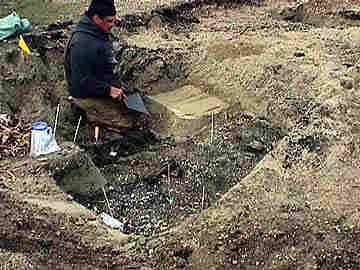15 July, 1998
07/15/98 A Day digging Test Pits
*** Up at 7 - a gasoline barge coming in - 10 hours of test pit digging -
the town showers and laundry reopens ***
Today's arrival of the gasoline barge finishes the town's
restocking of fuel. I spent all day with the bulk of the crew digging test
pits. The pits are 1-meter square and anywhere from .5 to 1 meter deep.
The pits are spaced 1 to 2 meters apart and are located along the
centerline of the future sewer line. The purpose of the pits is to help
better understand stratigraphic units (soil layers) and to ascertain the
likelihood of important archeology in certain locations. The stratigraphy
was fascinating, the artifacts were few and the work was strenuous. During
the day the village showers and laundry reopened. They had been closed
while the village water tank was being cleaned. After we finished work and
dinner (about 8:30) Aaron and I went to take a shower at the village
facility. Tomorrow I am going to try and pull off a laundry.
AARON'S ADDENDUM:
My wrist is starting to get sore. Tim and I were discussing it,
and we reached the conclusion that we have moved three or more tons of dirt
and gravel over the past four days, with a small trowel. After four days,
ten hours a day, my wrist and elbow feel like I've just pitched 500 curve
balls without warming up. It hurts, but not in a bad way.
Today I was trying to expose a 500-year-old house that had been
placed inside twelve hundred-year-old human graves. The graves had already
been removed, but the house is still there. It's a real puzzle to picture
what exactly happened and which artifacts belong to which people.

Ryan Peterson, cultural resource specialist, sketching test pits.

Stephanie Barr digging a test pit.

Alvin Iyatunguk excavating human remains.
Contact the TEA in the field at
.
If you cannot connect through your browser, copy the
TEA's e-mail address in the "To:" line of
your favorite e-mail package.
|
